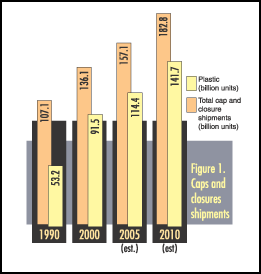Market Snapshot: Packaging 1920
February 1, 2002
It's nearly impossible to walk through any retail establishment without finding signs of plastic packaging. Consumer products from food and dairy, pharmaceutical, and household items to industrial products such as paint and spackle come in a variety of molded packages that offer convenience, better preservation qualities, and recyclability. As a market, packaging seems to offer unlimited opportunities for growth as plastics continue to replace glass, metal, and paper packaging.
Yet, molders serving this market saw slight growth in 2001, mostly in single digits as economic weakness made an impact. Still, packaging molders seem to be faring better than their counterparts servicing a variety of other markets. Greg Landis, president of Landis Plastics Inc. (Chicago Ridge, IL), says he's grateful to be in the food packaging industry, as it is the largest segment for rigid packaging. Although Landis Plastics' sales were up 9 percent in 2001, "I don't know that the whole market is up that much," comments Landis.
"We've always gotten some new business [each year], and most of the growth is in the cultured side of the business, such as snack dips and yogurt," he says. Landis Plastics currently operates five facilities dedicated to high-speed, high-volume injection molding and decorating of food containers.
| (est.) | (est.) |
Table 1. Dairy Products* | 1989 | 1993 |
Shipments (billion $) | 25.7 | 30.6 |
Total container demand (million $) | 1486 | 1571 |
Plastic container demand (million $) | 677 | 676 |
*excludes fluid milk and cream |
Growth is expected to continue in the dairy industry. A report by The Freedonia Group Inc. reveals that U.S. shipments of dairy products are projected to expand 3.8 percent yearly to nearly $54 billion in 2003 (see Table 1). Growth markets for dairy products include cheeses, especially specialty cheeses and bagel spreads; yogurt, especially dessert flavors and other items targeted towards children; organic dairy foods; and flavored creamers and ice creams.
The Freedonia report also notes that demand for food containers used to package nonbeverage dairy products and related nondairy substitutes will grow 2.4 percent annually to $2 billion by 2003, stimulated by good growth in dairy product shipments. Another good sign for molders of food containers is that "plastics containers have usurped most other applications from paperboard, although plastics continue to make inroads in frozen desserts and niche markets like grated Parmesan cheese," says the report.
However, the report adds that "plastic food containers will expand at a slow pace through 2003, having captured a significant market share from paper over the past several decades," but will "benefit from sustained growth in markets like yogurt and bagel spreads, with further inroads in applications like puddings and ice cream."
Berry Plastics Corp. (Evansville, IN) is a leading molder of packaging for a variety of markets including the dairy industry (yogurt and sour cream containers) and industrial products such as paint and spackling. The company also has an aerosol overcap business and a closures division that serves the milk, water, hair care, and pharmaceutical dispensing markets.
Curt Begle, Berry's marketing manager, says packaging will continue to be good business. "I think every study shows continuous growth in packaging and in particular plastics packaging," he says. "It's not a tremendous climb, but a steady one. Some markets we have yet to penetrate, and there are a lot of opportunities out there in the food industry specifically."
|
Figure 1. Caps and closures shipments |
Caps and Closures
The caps and closures market also represents a growth opportunity, according to a report by The Freedonia Group, with U.S. shipments of plastic caps and closures advancing 4.6 percent annually through 2005 to 114.4 billion units (see Figure 1). Material demand for this market should hit 2.5 billion lb by 2005. More than 70 percent of that material will come from the plastics segment, dominated by polypropylene and polystyrene, keeping plastic closures the largest and fastest growing industry segment.
Plastic closures will continue to benefit as plastic bottles and jars replace glass containers and compatible metal closures in applications ranging from baby food to hot-fill foods such as sauces and condiments. Technological advances are also allowing plastic closures to compete more effectively in glass packaging applications like wine.
Serving a number of markets and geographies, but focused on its molded products, The Aptar Group (Crystal Lake, IL) produces dispensing closures, pumps, and aerosol valves. This $1 billion corporation runs 700 to 800 injection molding presses worldwide, according to Steve Hagge, Aptar's cfo, and generates 60 percent of its sales outside the U.S.
Through the first half of 2001, Hagge says Aptar saw strong sales, up 9 percent. During the September time frame, Aptar saw a slowdown, and through Q3 2001 business was relatively good, but flat in terms of revenue and profitability. "There's a lot of uncertainty with our customers," Hagge notes. "In spite of the short-term issues, we're very positive about the long-term outlook for packaging."
You May Also Like



